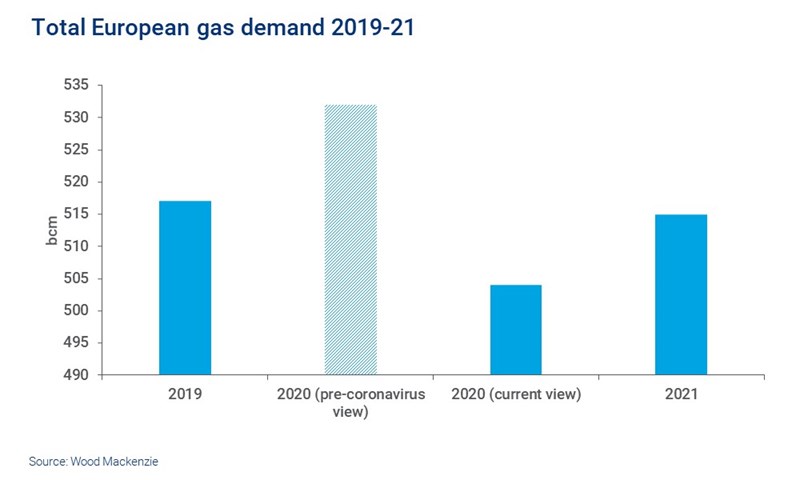Natural gas: friend or foe in Europe’s 2030 emissions target?
Green hydrogen has grabbed the limelight in the drive to decarbonise. But is there a role for natural gas in a post-coronavirus Europe?
1 minute read
Akif Chaudhry
Research Director, Corporate Strategy and Analytics

Akif Chaudhry
Research Director, Corporate Strategy and Analytics
Akif focuses on strategy, benchmarking and valuation analysis related to power and renewables within company portfolios.
Latest articles by Akif
-
The Edge
Renewable developers change tack
-
Opinion
Elevated subsidies enable offshore wind to end 2023 on a high note
-
Featured
Mixed signals for power and renewables in 2023
-
Opinion
Big Oil set to cash in on the trillion-dollar offshore wind prize
-
Featured
Power and renewables companies face merging headwinds in 2022 | 2022 Outlook
-
Opinion
Natural gas: friend or foe in Europe’s 2030 emissions target?
If Europe is serious about a more stringent 2030 emissions target – a key checkpoint on the way to net zero in 2050 – then gas offers a pragmatic solution.
Mention of natural gas as a ‘bridging fuel’ in the energy transition seems to have gone quiet over the past year or so. Instead, its carbon credentials have been in the spotlight.
The European Commission’s (EC) plan to drive beleaguered national economies out of the severe coronavirus-led downturn – building on the European Green Deal – gives little direct support to natural gas and carbon capture, utilisation and storage (CCUS) technologies. Hydrogen appears to be the holy grail – but it will take time to mature. Realistically, we think it will be another decade before the newer technology starts to make a meaningful contribution to decarbonisation.
So, is there a role for natural gas in a post-pandemic Europe?
Gas can help to bridge the gap
Fossil fuels are mostly out of favour. But gas could accelerate the displacement of coal-based power and industries, with the bonus that existing infrastructure can be leveraged. Although he didn’t provide much detail, the EC’s climate chief Frans Timmermans noted that gas will continue to play a key role in replacing coal as Europe shifts to more sustainable forms of energy. It will also allow time to build dedicated hydrogen infrastructure.
How has the coronavirus crisis changed Europe’s natural gas market?
The closure of non-essential services and industries has hammered electricity demand. But the fall in gas prices has lessened the blow to gas demand: gas has outcompeted coal in the power sector, and in traditionally coal-reliant Eastern Europe, gas-fired generation is up year-on-year.
Supply is a more significant concern, with the pandemic dealing a blow to new LNG project sanctions. As a result, supply growth will be severely squeezed by the middle of this decade. European gas prices will not drop as much as we previously thought, which will translate to less coal-to-gas switching.
While coal-to-gas switching will remain key to balancing the market in the near term, as we approach 2030, Europe will lose coal-fired capacity. More efficient, or cheaper, lignite plants will remain. And the economic argument for switching out coal for gas will weaken gradually. That will have a knock-on effect on emissions reduction.
How can Europe cut emissions faster as 2030 approaches?
There is a proven path to cutting emissions: ramping up coal phase-out through a combination of policy and financial assistance. Europe could also engineer a much higher carbon cost, or push governments to accelerate the removal of coal-fired generation. Even markets like Poland that rely heavily on coal have seen record gas consumption this year – which demonstrates the feasibility of fuel switching.
Swapping coal and oil for gas could also occur in industrial applications and district heating. That would depend on capital investment and access to gas infrastructure. In the residential sector, heat pumps are seen as key. However, encouraging this switch will take time.
Despite strong pledges from the EC and Germany, green hydrogen is still in its infancy.

Akif Chaudhry
Research Director, Corporate Strategy and Analytics
Akif focuses on strategy, benchmarking and valuation analysis related to power and renewables within company portfolios.
Latest articles by Akif
-
The Edge
Renewable developers change tack
-
Opinion
Elevated subsidies enable offshore wind to end 2023 on a high note
-
Featured
Mixed signals for power and renewables in 2023
-
Opinion
Big Oil set to cash in on the trillion-dollar offshore wind prize
-
Featured
Power and renewables companies face merging headwinds in 2022 | 2022 Outlook
-
Opinion
Natural gas: friend or foe in Europe’s 2030 emissions target?
Could hydrogen steal a march on gas?
Large supply-side investments will require regulatory guidance and a full understanding of value-chain costs. Even if hydrogen starts to make inroads in some sectors, displacing gas at scale in the residential market – the largest non-power market for natural gas – is highly unlikely any time in the coming decade.
Build your view of the global gas market with our Global Gas Model Next Generation. Fill in the form on this page to find out more.







